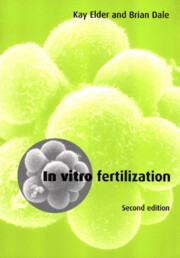Book contents
- Frontmatter
- Contents
- Preface
- Acknowledgments
- 1 Introduction
- 2 Producing gametes
- 3 Sperm–oocyte interaction
- 4 First stages of development
- 5 Endocrine control of reproduction
- 6 Assisted reproductive technology in farm animals
- 7 The clinical in vitro fertilization laboratory
- 8 Semen analysis and preparation for assisted reproductive techniques
- 9 Oocyte retrieval and embryo culture
- 10 Cryopreservation
- 11 Micromanipulation techniques
- 12 Preimplantation genetic diagnosis
- Index
3 - Sperm–oocyte interaction
Published online by Cambridge University Press: 15 August 2009
- Frontmatter
- Contents
- Preface
- Acknowledgments
- 1 Introduction
- 2 Producing gametes
- 3 Sperm–oocyte interaction
- 4 First stages of development
- 5 Endocrine control of reproduction
- 6 Assisted reproductive technology in farm animals
- 7 The clinical in vitro fertilization laboratory
- 8 Semen analysis and preparation for assisted reproductive techniques
- 9 Oocyte retrieval and embryo culture
- 10 Cryopreservation
- 11 Micromanipulation techniques
- 12 Preimplantation genetic diagnosis
- Index
Summary
The acrosome and the vitelline coat
In Nature, fertilization is a complex process of cell–cell interaction which starts with the specific recognition and binding of spermatozoa to oocytes and ultimately leads to the fusion of the male and female pronuclei. The initial stages of fertilization depend principally on two structures: the acrosome of the spermatozoon (Figure 3.1) and the vitelline coat or zona pellucida of the oocyte. For convenience, we may consider three major events in sperm–oocyte interaction:
Attachment of the spermatozoon to the vitelline coat (zona pellucida).
The spermatozoon undergoes the acrosome reaction, as a result of which digestive enzymes are released and the inner acrosomal membrane is exposed.
This highly fusogenic sperm membrane makes contact with the oocyte plasma membrane and the two membranes fuse together.
The vitelline coat is composed of protein and carbohydrates in the form of glycoprotein units which are probably stabilized by disulphide bonds. The principal carbohydrate appears to be fucose and the glycoprotein units are synthesized by the oocyte itself. The form of the vitelline coat varies greatly from species to species. For example, in the sea urchin the vitelline coat is very thin and adheres tightly to the oocyte surface following the contours of the surface microvilli, whereas in the starfish it is much thicker and is perforated by the microvilli. The situation in mammals and ascidians is quite different: the vitelline coat is extremely thick and, in fact, it may be removed manually using fine steel needles.
Information
- Type
- Chapter
- Information
- In Vitro Fertilization , pp. 34 - 65Publisher: Cambridge University PressPrint publication year: 2000
